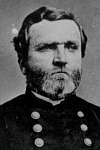Thomas of Nashville

George Henry Thomas was not a man to be hurried as illustrated by one of his formidable list of nicknames, 'Slow Trot' bestowed upon him by his West Point cadets in the days when he had been an instructor there. In the autumn of 1864 he was commander, with the rank of Brevet Major General, of the Union's Army of the Cumberland which he had led with some success at Missionary Ridge and in the campaigns with General Sherman during the preceding year.
In the early winter of 1864, the Confederate General Hood, with an army estimated as anything between 23,000 and 40,000 men, hoped to break through Tennessee into Kentucky. There he expected he would be able to pick up thousands of recruits, destroy Thomas' army and then move east into Virginia, link up with Lee and jointly defeat the Army of the Potomac - General Mead commanding, General Grant in overall charge.
In the closing days of November, Hood advanced. Things looked good until he confronted the Federal General Schofield, whom he failed to envelop with his cavalry and also failed to destroy Union forces at Spring Hill, who managed to withstand several Rebel assaults before withdrawing to Franklin, some fifteen miles south of Nashville. Hood was furious, blaming everyone but himself. At Franklin, he ordered his troops to make a head-on attack upon their Union foes, despite the fact that most of his artillery was far in the rear and much of his cavalry were elsewhere. Twenty two thousand Confederate infantrymen attacked; the fighting became hand-to-hand but eventually the Rebels were forced to pull back. Desultory fighting continued into the dark hours and Schofield was able to break off and move north to Nashville. Hood's casualties had been 7,000 (three times the Federal numbers) including no less than a dozen Generals, six of whom had been killed. These included Pat Cleburne, one of the most able and far-sighted Confederate Generals of the war. Despite these losses, Hood would not be deflected; he marched his army onwards towards Nashville and entrenched his battered troops along a line of hills south of the Capital of Tennessee. He then waited for Thomas to attack.
So did Grant, Commander-in-Chief of the U.S. Armies; So did Stanton, Secretary for War; So did Lincoln, President of the United States.
Stanton raged and stormed, as was his way that Thomas was no good and his inactivity looked like McClellan's policy of doing little and allowing the Rebels to raid the Country at will. Lincoln pondered quietly, as was his way. Grant, seeming to lose his nerve for the first time in his military career, sent telegram after telegram urging Thomas to attack. As he put it when reminiscing years later:
"At last I had to say to General Thomas that I should be obliged to remove him unless he acted promptly. He replied that he was very sorry, but he would move as soon as he could."
And Thomas intended to move as soon as he could. As soon as there was frost. As soon as the ground was hard enough for him to readily move his troops and guns - he waited; Grant despaired.
"General Logan happening to visit City Point about that time and knowing him as a prompt, gallant and efficient officer, I gave him an order to proceed to Nashville to relieve Thomas .... I became restless and concluded to go myself."
But by this time Thomas had moved. The fight that followed, The Battle of Nashville has been described by one historian (McPherson) as "like Joe Louis' second fight with Max Schmeling," a knock out that almost destroyed the adversary.
One division pinned down Hood's right with a left jab while three corps cracked the other flank with a devastating right.
As usual the Rebels fought stubbornly and valiantly and hung on until at last, under hammer-like blows at their left, they retreated a couple of miles, forming a shorter line with a hill at both ends.
The next day, 50,000 Union troops advanced and again the Confederates hung on until, by late afternoon after dismounted US cavalrymen had moved around to their rear, and using their rapid firing Sharps Carbines to create carnage, the Rebels collapsed. They ran, abandoning their guns, small arms and much other equipment.
For nearly two weeks there was a chase, the Federals attempting to kill, maim or capture as many Rebels as possible. Indeed had it not been for some skilful rear-guard action by that frightful genius Nathan Bedford Forrest, Hood's army may well have been obliterated. As it was, its routed remnants ended up at Topelo, Mississippi. In effect, a Confederate army had been destroyed.
General Hood "resigned" on the 13 January.
Thomas' victory at Nashville, however numbers or other factors may have assisted him, was the most complete victory in a major engagement won by either side in the American Civil War.
Congress voted Thomas its thanks.
Secretary Stanton lay low and said little.
Terry Haynes, Pvt. 2ndUS, Artillery.
Sources:
Mark M Boatne, The Civil War Dictionary
US Grant Personal Memoirs
James P McPherson, Battle Cry of Freedom
W Burbeck Wood and Colonel J E Edmonds R.E., A History of the Civil War in the United States 1861-65
The above article first appeared in the ACWS Newsletter, August 1998
